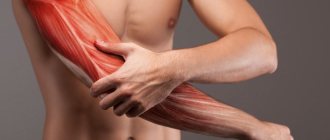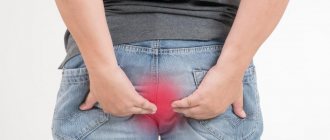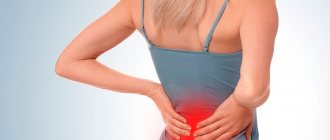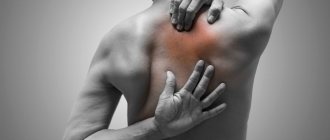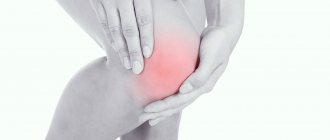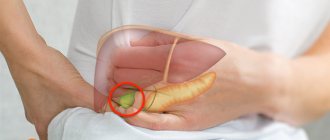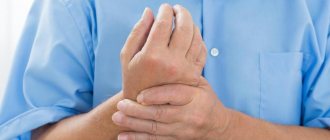Symptoms
- Pain in the tailbone when sitting is a manifestation of the consequences of injuries, a sedentary lifestyle, microtrauma from sports;
- Aching pain can occur with pelvic inflammation, osteochondrosis or hemorrhoids;
- Sharp burning pain is characteristic of injuries to the coccyx when falling backward;
- Pain when standing up, radiating to the tailbone, is a symptom of various diseases: from prolapse of the perineum to pathology of the pelvic bones. They may also be a sign of the formation of adhesions and scars after surgery or difficult childbirth;
- Acute pain that occurs when moving is most often caused by a pinched nerve.
To correctly identify the disease, it is necessary to undergo an examination. For coccydynia, palpation diagnostics, urological examination, MRI, radiography and CT may be prescribed. After research, treatment is prescribed that corresponds to the nature of the disease.
Statistics show that women more often than men suffer from pain in the coccyx, as they are more susceptible to pelvic diseases and lumbar osteochondrosis.
Diagnosis of the problem
For diagnostic purposes and to exclude a wide range of diseases, the patient is examined to identify the source of coccydynia - an examination is carried out during which the anal canal, rectum, organs of the reproductive system, lumbar and sacral spine are examined.
The use of hardware examination methods is justified:
- X-ray of the spinal column showing degenerative changes in the lumbar and sacral regions;
- CT and MRI;
- Ultrasound of the reproductive system and pelvic organs.
Treatment of pain in the coccyx
Procedures aimed at eliminating coccygeal pain depend on the causes of the disease and may include:
- Taking painkillers (most often in the form of injections, suppositories or microenemas);
- Massage, exercise therapy, manual therapy, which will help with osteochondrosis and circulatory disorders in the lumbar region;
- Reflexology, which is designed to alleviate spasms and acute pain;
- Physiotherapy, in particular shockwave therapy (shock wave therapy). This technique is based on the use of acoustic waves that pass through the tissue and destroy salt deposits, eliminate congestion in the coccyx area, and help resolve postoperative scars. In addition, shock sound waves accelerate the healing process of tissues and restore normal blood circulation, which is especially important for traumatic and postpartum pain.
Who should I contact if I have pain?
My tailbone hurts, what should I do in this case? Coccydynia often has a history of a large number of different pathological processes, so the choice of a specialist to whom you should immediately contact should be made taking into account the source of the problem:
- traumatologist - provides assistance when the tailbone hurts;
- You can also contact a surgeon for help in case of injuries or manifestations of coccydynia during pregnancy and after childbirth;
- a gynecologist and urologist specialize in diseases of the genitourinary system leading to coccydynia;
- a proctologist treats diseases that provoke coccydynia, such as pathologies of the rectum (hemorrhoids, proctitis, colitis, etc.), anal deformity;
- An osteopath, a vertebrologist, and a chiropractor work with the unknown factor of the presence of pain and its absence when you relax.
You can contact specialists at the Aspect of Health neurology and neurorehabilitation clinic in Ufa. In our clinic, consultations are conducted by highly qualified specialists who will help localize the source of coccydynia and draw up a plan for what to do if the tailbone hurts, avoiding unnecessary medications and surgeries.
Prevention of coccydynia
In order not to suffer from pain in the tailbone, try to sit correctly, do not “overuse” soft chairs, pillows, poufs - an incorrect and unfixed posture when sitting can cause the development of osteochondrosis. Also, do not wear clothes that are tight at the waist or tight jeans.
During pregnancy, women are recommended to use a support bandage to avoid deformation of the posterior part of the spine. And finally, doctors advise moving more and doing exercises regularly, which will allow you not only to avoid coccygeal pain, but also to keep your body in good shape as a whole.
If you do have diseases that cause coccydynia, then at the medical center you can undergo a course of shock wave therapy and get rid of pain.
Why does my tailbone hurt?
The reasons for which the tailbone hurts can be divided into the following types:
- Primary coccydynia - various damage to the organ structure leads to the development of pain. Often the reason why the tailbone hurts in women can be, for example, labor, etc.
- Secondary coccydynia - this type of pathology is more common, discomfort is associated with diseases of adjacent organs (bladder, intestines, uterus). The patient is concerned about secondary symptoms, which the doctor must take into account when making a diagnosis and prescribing treatment.
Diagnostic measures
Only a specialized specialist can determine how to treat a bruise of the coccyx and sacrum. It all depends on the type of injury and the general condition of the patient. At the appointment, an initial examination is performed with palpation of the injured area.
If there is a suspicion of a dislocation or fracture, an x-ray is prescribed.
A myelogram is performed to rule out spinal cord damage.
Densitometry may also be prescribed to determine the degree of fragility of the spine. The procedure is mandatory if there is suspicion of osteoporosis. During the treatment process, computer diagnostics may be prescribed, the purpose of which is to identify possible neoplasms of bone and soft tissue. Diagnostic measures allow not only to identify pathology, but also to decide how to treat the tailbone after a bruise.
Checklist against illness
The first thing that will help determine the disease is the symptoms. Clarification is needed for pain in the back of the thigh: it is pulling in nature, shooting, is constant, occurs in some poses, increases/decreases with movement, and so on. In this case, it is important to understand whether the buttock or the back of the thigh underneath it hurts. This may be accompanied by:
- pain in the buttock when sitting;
- burning sensation in the thigh and buttock;
- painful sensations on the outer or inner side of the lower leg;
- pain and/or partial loss of sensation in the foot.
All these sensations can be observed only on one leg or on both legs at once. In the second case, it is important to note whether the intensity of the pain is the same.
When recording symptoms, it is necessary to note whether they are somehow related to postures during work and rest. For example, if you slept on your right side and you feel tolerable, but if you slept on your left, it’s difficult to even get up.
You should also note any unusual sensations. A feeling of heat in the feet and even sudden sweating of the feet will definitely interest a good neurologist or vertebrologist.
What is the coccyx and why is it needed?
The tailbone is the final part of the spinal column. It consists of three to four (less often five) fused vertebrae and is connected to the sacrum via an intervertebral disc, which allows the coccyx to deviate. The coccyx has the shape of an inverted pyramid and looks like a bird's beak, with the width always exceeding the length.
The pubococcygeus, iliococcygeus and coccygeus muscles, the anal-coccygeal ligament, as well as part of the gluteal muscle bundles are attached to this organ. Although the coccyx is considered a rudimentary part of the spine, in fact it performs a number of important functions:
- Participates in uniform distribution of the load on the spinal column.
- Due to its displacement and expansion of the birth canal, it ensures the normal passage of the fetus during childbirth.
- Promotes normal mobility of the hip joint.
- Serves as an attachment point for ligaments and muscles that ensure the functioning of the pelvic organs and lower intestine.
- Participates in the implementation of the support function when squatting and bending the body.
What diseases can cause pain
Aching or other pain in the lower back appears for the following reasons:
- hemorrhoids, when the rectum descends, its microflora is disrupted, lesions and micro-tears occur;
- sciatica (lumbosacral radiculitis);
- anal fissure;
- paraproctitis;
- arthrosis;
- arthritis;
- intervertebral hernia;
- displaced vertebrae in the spine.
The disease cannot be determined by its symptoms, so a whole range of studies may be required to determine the exact cause of the pain.
Treatment methods
In most cases, conservative treatment is sufficient, but the decision should only be made by a doctor. Pain syndromes are relieved with medications, and during the period of exacerbation the patient is provided with rest. After acute attacks are relieved, massage or physical therapy can be performed, thereby improving blood circulation. Exercises related to lifting weights, running, jumping, and sudden movements are excluded from the complex. Treatment for pregnant women is more difficult; painkillers and anti-inflammatory drugs are contraindicated for them in most cases. The only recommendation is to be patient and take the most comfortable positions. The body needs to be prepared for the period of pregnancy from an early age; it is at this time that the health of future mothers is laid. The better your health, the easier it is to endure pregnancy and childbirth.
To relieve moderate discomfort, Ibuprofen is prescribed.
Ibuprofen in gel form
Severe pain is relieved with novocaine blockades; it is recommended to use Diprospan, Lidocaine or Hydrocortisone.
"Hydrocortisone"
Surgical methods are used in the most difficult cases that are not amenable to therapeutic intervention. New growths near the tailbone or the organ itself can be removed. The decision is made after a detailed examination of the patient using modern medical equipment.
Physiotherapy
Official medicine uses the therapeutic effect of natural and artificially created factors on a sick body. Patients can be prescribed a complex of ultrasound treatment and exposure to low voltage currents.
Why do you need to see a doctor right away?
If characteristic symptoms are present several hours after a tailbone injury, the consequences of the injury can be serious. A doctor’s consultation and diagnosis are necessary, because often we are talking about more than just soft tissue damage. Typical pathologies include:
- dislocations and subluxations;
- fractures;
- vertebral displacement;
- sprains, rupture of tissues and ligaments.
Without a medical examination, it is impossible to determine the consequences of the injury. If you don’t know what to do or how to treat a bruised tailbone, the doctors at our clinic will not only provide first aid, but also select the best rehabilitation options.
What is the danger of not paying attention to such a problem as a bruised tailbone? In addition to serious injuries that can be hidden behind a banal fall into ice, dysfunction of the musculoskeletal system is possible, up to the development of paralysis of the lower extremities. Among serious pathologies, experts note problems with childbirth in women, loss of sensitivity in the intimate area due to compression of nerve endings. Over time, fistulas or bone calluses, benign or malignant neoplasms may appear at the site of injury.
Exercises to relieve pain
One of the simplest complexes for pain in the coccygeal area is gymnastics with a ball. Regular exercise allows you to get rid of pain and strengthen the pelvic floor muscles, including the pubococcygeus. If it hurts during exercise, then you must immediately stop doing gymnastics. The main part of the exercises is performed lying on the floor.
Approximate charging complex:
- Lying on your back, pull your knees bent towards your chest. Then perform the fly-out 10-12 times, resting 10-15 seconds between sets.
- Remaining in the same position, place a medium-sized ball between your knees. It is necessary to squeeze it for 5-7 seconds, then relax for 10-15 seconds. Repeat the exercise 6-8 times.
- Straighten your legs, roll the ball to your feet and squeeze it with the inner surface of your ankle joints for 5-7 seconds. The number of approaches is 6-8 times, with a rest interval of 10-15 seconds between them.
- In a lying position, bend your legs and place your feet as close to your buttocks as possible. Smoothly raise and lower your pelvis without putting pressure on your back. All the work falls on the gluteal muscles, back muscles, abs and pelvic floor (including the pubococcygeus).
- The “boat” exercise, when lying on your stomach, the upper and lower limbs are raised as high as possible above the floor. Repeat 2-3 times with a five-second break between sets.
- The final stage of charging will be smooth bends and turns of the body to the sides in a standing position.
After gymnastics, it is advisable to do a light massage of the coccygeal area.
How to minimize the consequences of an impact?
The first thing to do when you bruise your tailbone is to minimize the load on the spine. If possible, you need to lie on your stomach and wait until the pain subsides. Then try to get up, listening to your feelings. Severe pain may indicate serious injury that requires immediate medical attention.
What to do if you have a severe bruise on your tailbone, if you can’t see a doctor right away? You need to try to minimize the consequences of the injury on your own. First, you should apply something cold to the bruised area to prevent swelling. Any analgesics, as well as various ointments and gels, can be used as painkillers, but provided that the skin at the site of the bruise is not damaged. First aid largely determines how long a bruised tailbone takes to heal.

